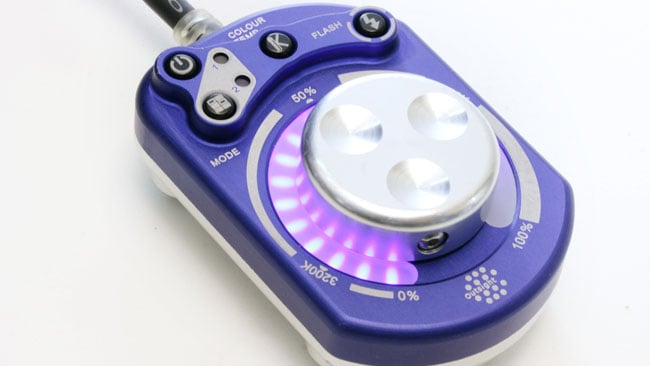
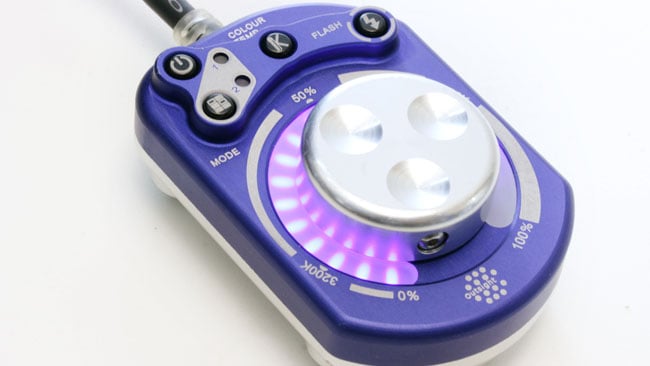 One way of getting rid of rolling shutter
One way of getting rid of rolling shutter
Rolling shutter is an issue at all levels of camerawork. One solution to get rid of it though is to synchronise the light frequency to the camera, and one of the few lights that actually accepts a synchronising signal from a camera is Outsight's Creamsource LED panels.
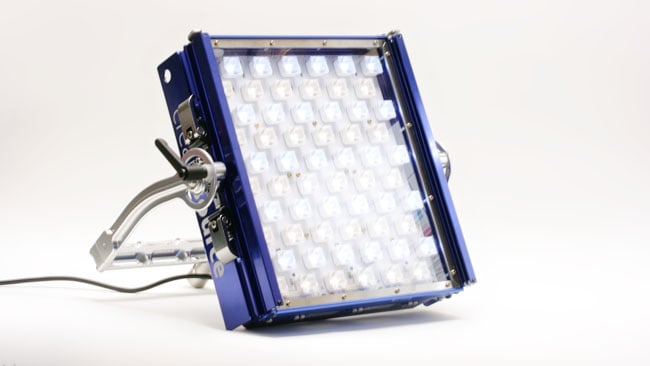
As we've seen before, rolling shutter is an issue at all levels of camera work. On an Alexa, it's so fast as to be almost invisible unless we're trying to shoot gunfire. Lesser cameras are notorious for producing noticeable distortions in moving objects. Depending on the construction of the camera involved, even film cameras can create a wobble in strobe illumination as one edge of the frame can be exposed a little before the other. It's still quite possible to miss flashes altogether, as can sometimes happen with firearms effects. If the story requires a gunshot to be visible to the audience, this can become a real time sink.
One solution to this problem is a light synchronised to the camera, and one of the very few lights that actually accept a synchronisation signal from the camera is Outsight's Creamsource range of LED panels. While this is not a new product, there are few other ways to do this. And as it’s rarely discussed, it seemed worth looking into.
The Creamsource panel itself is available in two versions. They're rated at 150W for the smaller roughly foot-square type, and at 350W for the larger one. The design uses a relatively small number of higher-power LEDs with individual collimating optics and is therefore among the LED lights with a narrow beam. This is flexible since a narrow beam can be diffused, whereas a broad beam is difficult to make directional. There are models with variable colour temperature, and the firmware is complete, including various strobe and flash effect modes that work with or without external synchronisation.
Outsight products and build quality
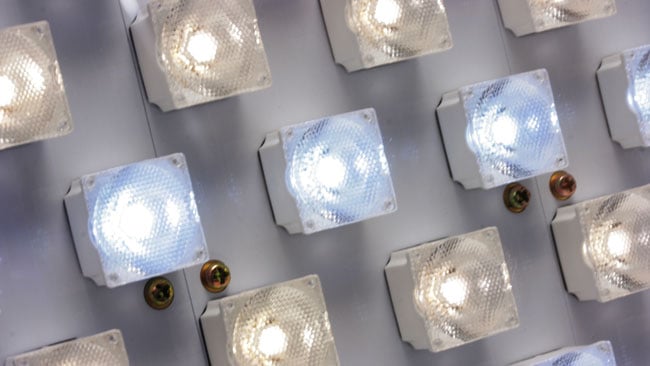
The most noticeable thing about Outsight's product line is the dedication to mechanical construction quality and a high standard of industrial design. The chassis of a Creamsource panel is made mainly of extruded aluminium. That isn't particularly unusual but there are a lot of machined parts and the way in which the control panels and connectors are assembled is very nicely done. The rotary menu control shows practically no flexibility or wobble. The entire yoke assembly is made from parts machined from solid metal and bolted together, as opposed to the usual piece of bent metal.
The feel of quality continues into things like the handheld controller, which, like the rest of the device, is anodised in blue and silver. The case and rotary control are machined throughout and an attractive ring of blue LEDs indicates control functions. The result is something that looks like a hand prop from a high-budget science fiction movie, and while the prettiness is nice, the indestructibility is useful.
Outsight's products are probably in the top third of the LED lighting price range and we should expect quality, but the Creamsource panel supplied on review (a Mini+, about $2200 at B&H) has a noticeably better quality of build than competing products at rather higher prices.
Effects and setup
Available effects include random flicker with parameters that allow simulation of anything from welding to a faulty fluorescent tube. There are straightforward strobe modes and one designed for photographers with more selectable levels for a modelling light than a high-power flash. The device that allows these effects to be camera-synchronised is called the Flashbandit. It's a small box with a BNC connector to receive the video signal and a cable to run to the LED panel's Lemo control input. There's also a Lemo input connector as Outsight has designed the controllers to be daisy-chained. Thus, synchronised flash effects can be commanded using the hand controller with no loss of functionality.
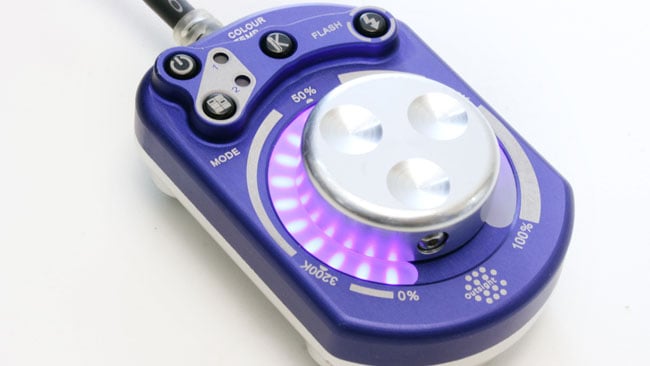
Flashbandit is relatively straightforward to set up. A light flickers at the frame rate when a signal is received. There's a menu option that allows adjusting the phase that causes the light to flash (dimly) at the recording frame rate. It also allows the user to make adjustments using the rotary control until no light is visible in the camera's viewfinder. Once adjusted, the hard link between the camera and the light will ensure that rolling shutter effects are entirely avoided.
Synchronisation does somewhat alter the behaviour of some of the effects. It seems to suppress any flash that would create a torn frame. This — with some very specific effect settings — can cause the light to appear to be almost continuously off if things happen to line up in exactly the wrong way. You can correct this by adjusting the parameters of the flash effect, so it's really necessary to adjust settings with the synchronisation active in the first place.
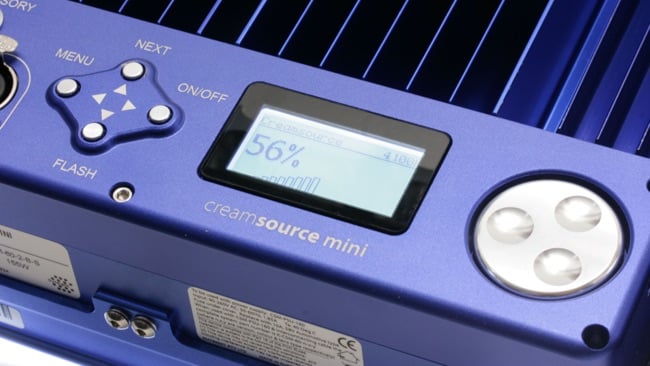
Other modes, particularly the “flash frames” option, are very useful with synchronisation as they are capable of specifically illuminating a given frame or group of frames. This is good for gunshots, as it's possible to select a one-frame ON time, then a long OFF time. By pressing the flash button, the next available frame will reliably contain a flash. This won't be repeated until the long OFF time has passed, which is time enough to release the button. Press again and another flash occurs. In concert with a bit of engineering from the props people, this can lead to a completely automated way to simulate gunfire.
Flashbandit requires analogue video signal
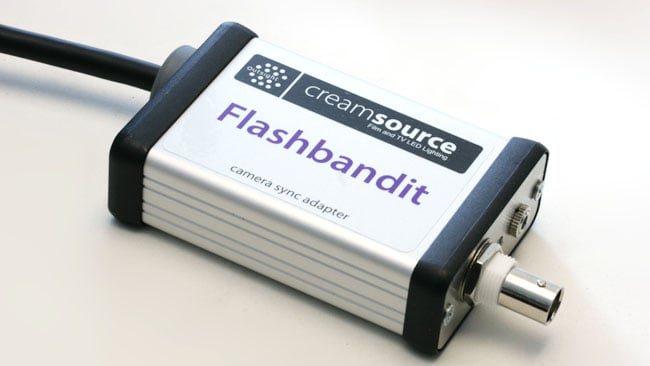
The only thing to bear in mind is that Flashbandit requires an analogue video signal. The equipment supplied on review was tested with a Blackmagic Ursa Mini 4.6K, which lacks analogue outputs, so Blackmagic's SDI to analogue converter was required. This means another box on the light, finding a way to power it as well as extra cables lying around — although it isn't the end of the world.
There are engineering realities which make Outsight's approach here reasonable –—SDI is much more difficult to handle than analogue video and would have made the Flashbandit device big, expensive and power-hungry. About the only thing that’s missing is a way to have controllable, randomly varying intensity with the “flash frames” option. That would allow for a more accurate simulation of the way fully-automatic gunfire often interacts with camera shutter timing.
Outsight's Creamsource is among the most powerful examples of its type and is beautifully designed and built. While it's a high-end product and priced as such, it is not outrageously expensive for what it does and the Flashbandit accessory is near-unique. The company even offers upgrade kits to keep its older products up to date, which is practically unheard-of. Overall it's easy to like it and no, there is no longer an excuse for big movies to be released with rolling shutter artefacts.
Tags: Production


Comments